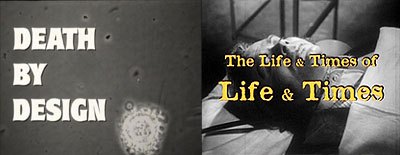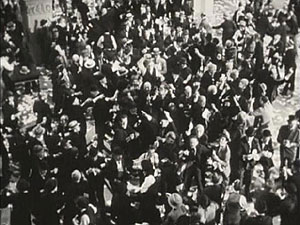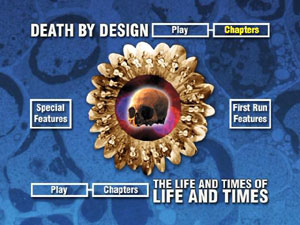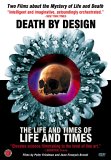| Reviews & Columns |
|
Reviews DVD TV on DVD Blu-ray 4K UHD International DVDs In Theaters Reviews by Studio Video Games Features Collector Series DVDs Easter Egg Database Interviews DVD Talk Radio Feature Articles Columns Anime Talk DVD Savant Horror DVDs The M.O.D. Squad Art House HD Talk Silent DVD
|
DVD Talk Forum |
|
|
| Resources |
|
DVD Price Search Customer Service #'s RCE Info Links |
|
Columns
|
|
|
Death By Design/The Life and Times of Life and Times
Inside the deadly world of cells

Reviewer Bias*
Loves: None
Likes: Artistic Documentaries
Dislikes: Science Documentaries
Hates: Dying
The Movies
Death by Design is considered one of the best scientific documentaries, as it combines high-level microbiology with a mainstream way of delivering information to create an interesting and often entertaining look at cells and how they work. This doesn't sound like something many people would choose to watch on their own, but it's not anything like the films you were forced to watch in school.
There's plenty of science being discussed in this film, but the key concept is programmed cell death, which explains how cells live and die in order to make organisms work. I would consider myself to be a moderately intelligent person, and I took all the science courses needed to graduate college, but there's a tremendous amount of information in this film that I never knew. Cell death might be the most important ideas in biology in terms of curing diseases like cancer and extending human life.
Looking at that last paragraph, I realize, the film sounds boring, but by using old films and cartoons to illustrate the various concepts introduced, the film achieves a unique feel among science documentaries. Right from the start, where the opening titles appropriately parody old science-fiction films, the mix of serious science and comedic delivery strikes the proper balance in order to present the film's concepts in a way in which they will be easily received.
The use of visual analogy in the film is of such a level of quality that it feels natural, whereas it could have been a choppy mess. I'd be tempted to compare it to master editor Orson Welles' F for Fake, but I'd be risking downplaying Welles. At one point, when discussing how cells are overproduced to find just the right one, the interview is shown on an editing bay, where overproduced film is edited to find just the right one. It's an oft overused term, but it's a moment of genius in this 70-minute film.
 One of the concepts at the core of The Life and Times of Life and Times is so simple, yet it's one that most people have never considered, mainly due to fear of mortality. Once you no longer are of reproducing status, you essentially have no real use to society. Sure, your family may like you, and you like you, but you no longer offer the world anything that someone else couldn't do. That's a hard concept to accept, but in the realm of evolution, it makes perfect sense. Your "job" is to advance the species, and when you no longer do your job, you get "fired."
One of the concepts at the core of The Life and Times of Life and Times is so simple, yet it's one that most people have never considered, mainly due to fear of mortality. Once you no longer are of reproducing status, you essentially have no real use to society. Sure, your family may like you, and you like you, but you no longer offer the world anything that someone else couldn't do. That's a hard concept to accept, but in the realm of evolution, it makes perfect sense. Your "job" is to advance the species, and when you no longer do your job, you get "fired."
Like in Death by Design, the scientists in Life and Times utilize common analogies, like being dumped by a girlfriend or diagnosing problems with a car, to explain the complex concept of aging (or as one scientist prefers to call it, "the biology of time.") A mix of old film footage and well-selected visual analogies help put concepts that are, for most people, too foreign to understand, into simple, manageable boxes. In the end, the idea that genetics may play a huge role in how humans age is laid out in a way that anyone could understand.
The documentary doesn't stop at explaining aging, whether it might be the accumulated effects of life, a preprogrammed course or something else, but also looks at how aging could be reduced, and whether that's an idea that's even worth exploring. Watching the elderly people shown in this film, as they struggle, it's asked if anyone would want to live longer if it means living longer at this diminished capacity.
If may be the main subject, the universally reviled concepts of aging and death, but this film isn't as fun as Death by Design. There seems to be less of the intercutting and film collage work in this film also, as beautiful images of aging and death in nature and interviews with the scientists make up the majority of this shorter, 59-minute film.
 The DVD
The DVD
Death by Design and The Life and Times of Life and Times are presented on one DVD, which comes packaged in a standard keepcase, with a catalog of First Run Features DVDs. The main menu is static and full-frame and is accompanied by some theme music. Options are available to play either film, choose chapters, view special features and check out an info screen about First Run Features. Chapter selection menus include text lists of chapter stops, while there are no audio options, subtitles or closed captioning.
The Quality
In terms of the full-frame footage shot specifically for the film, Life and Times, which is two years younger than Death by Design, looks much brighter and crisper than its predecessor. Both films have a good amount of detail and have no concerns about dirt or damage, but Life and Times is simply beautiful to look at, especially during shots taken in the desert. The old film footage used in both films varies based on the source, but nothing looks awful, as they have the dirt and damage one would expect from such material, and which one would want for effect.
The audio is presented in Dolby Digital 2.0, and the mix is solid, but nothing overwhelming, as it's a standard documentary soundtrack, made up mostly of well-recorded dialogue and music that doesn't interfere.
The Extras
The extras are a bit slim here, starting with "Suicides without Sadness," a two-page Nature magazine article about the film, presented on the disc as a PDF file. This article isn't likely to appeal to the film's audience, as it's loaded with the jargon and complicated concepts the filmmakers cut through.
Text biographies are available for Friedman and Brunet, as well as a trailer for Friedman's unique film Mana - Beyond Belief. Five more First Run Features trailers are also included.
 The Bottom Line
The Bottom Line
These films do science a tremendous service by illuminating ideas that are beyond comprehension for many, and doing it in a way that's entertaining and more engaging than any episode of "Nova." The presentation of the films is excellent, though the extras are sparse. This DVD should appeal to fans of science and is highly recommended for use in the classroom, where students are likely to get more out of it than the standard documentaries. Though most people won't find the need to own this DVD, they should absolutely check it out.
Francis Rizzo III is a native Long Islander, where he works in academia. In his spare time, he enjoys watching hockey, writing and spending time with his wife, daughter and puppy.Follow him on Twitter
*The Reviewer's Bias section is an attempt to help readers use the review to its best effect. By knowing where the reviewer's biases lie on the film's subject matter, one can read the review with the right mindset.
|
| Popular Reviews |
| Sponsored Links |
|
|
| Sponsored Links |
|
|
| Release List | Reviews | Shop | Newsletter | Forum | DVD Giveaways | Blu-Ray | Advertise |
|
Copyright 2024 DVDTalk.com All Rights Reserved. Legal Info, Privacy Policy, Terms of Use,
Manage Preferences,
Your Privacy Choices | |||||||















